Citroen BERLINGO MULTISPACE 2015 2.G Manual PDF
Manufacturer: CITROEN, Model Year: 2015, Model line: BERLINGO MULTISPACE, Model: Citroen BERLINGO MULTISPACE 2015 2.GPages: 298, PDF Size: 12.69 MB
Page 71 of 298
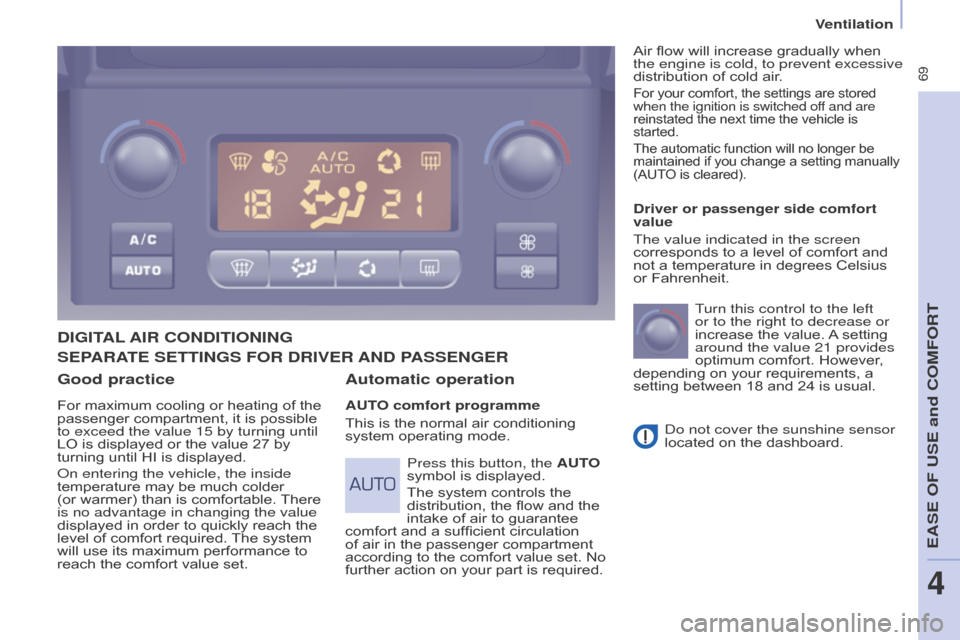
69
Berlingo-2-VP_en_Chap04_Ergonomie_ed01-2015Berlingo-2-VP_en_Chap04_Ergonomie_ed01-2015
Good practice
For maximum cooling or heating of the passenger compartment, it is possible
to exceed the value 15 by turning until
LO
is displayed or the value 27 by
turning
until HI is displayed.
o
n entering the vehicle, the inside
temperature
may be much colder
(or
warmer) than is comfortable.
There
is no advantage in changing the value
displayed
in order to quickly reach the
level
of comfort required.
The
system
will
use its maximum performance to
reach
the comfort value set.
DIGITAL AIR CONDITIONING
Automatic operation
AUTO comfort programme
This
is the normal air conditioning
system
operating mode. Driver or passenger side comfort
value
The value indicated in the screen
corresponds
to a level of comfort and
not
a temperature in degrees Celsius
or
Fahrenheit.
Turn this control to the left
or to the right to decrease or
increase the value.
A
setting
around the value 21 provides
optimum
comfort. However,
depending
on your requirements, a
setting
between 18 and 24 is usual.
d
o not cover the sunshine sensor
located
on the dashboard.
Press this button, the AUTO
symbol
is displayed.
The
system controls the
distribution,
the flow and the
intake
of air to guarantee
comfort
and a sufficient circulation
of
air in the passenger compartment
according
to the comfort value set. No
further
action on your part is required.Air
flow will increase gradually when
the
engine is cold, to prevent excessive
distribution of cold air.
For your comfort, the settings are stored when the ignition is switched of
f and are
reinstated
the next time the vehicle is
started.
The
automatic function will no longer be
maintained
if you change a setting manually
(AUT
O is cleared).
SEPARATE SETTINGS FOR DRIVER AND PASSENGER
EASE OF USE and COMFORT
4
Ventilation
Page 72 of 298
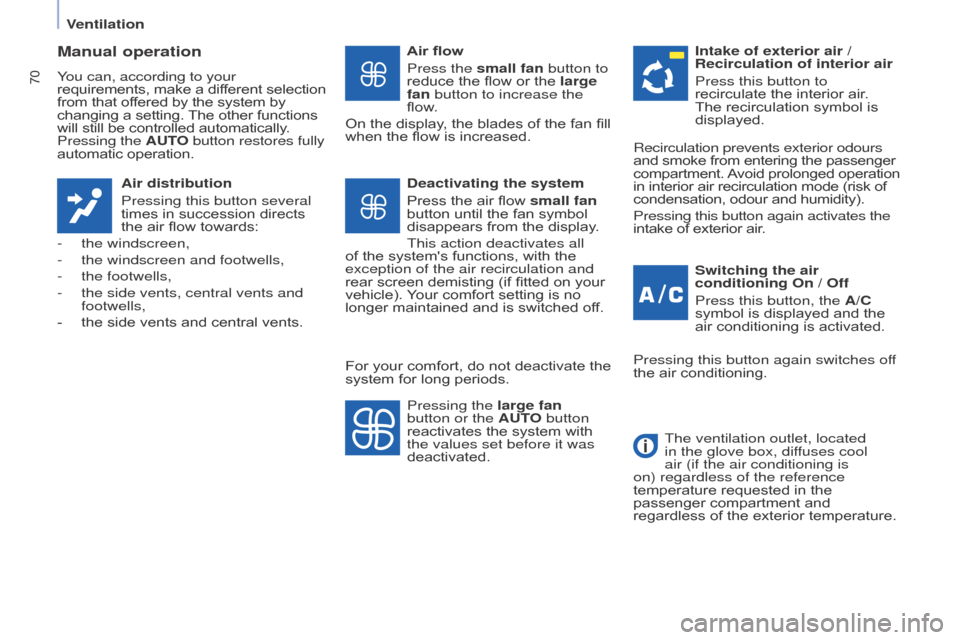
70
Berlingo-2-VP_en_Chap04_Ergonomie_ed01-2015Berlingo-2-VP_en_Chap04_Ergonomie_ed01-2015
Manual operation
You can, according to your
requirements, make a different selection from
that offered by the system by
changing
a setting.
The
other functions
will
still be controlled automatically.
Pressing the
AUTO button restores fully
automatic
operation.
Air distribution
Pressing this button several
times
in succession directs
the
air flow towards:
-
the windscreen,
-
the windscreen and footwells,
-
the footwells,
-
the side vents, central vents and
footwells,
-
the
side vents and central vents.Air flow
Press the small fan button to
reduce
the flow or the large
fan button to increase the
flow.
On
the display, the blades of the fan fill
when
the flow is increased.
Switching the air
conditioning On / Off
Press this button, the A/C
symbol
is displayed and the
air
conditioning is activated.
Deactivating the system
Press
the air flow small fan
button
until the fan symbol
disappears
from the display.
This action deactivates all
of
the system's functions, with the
exception of the air recirculation and
rear
screen demisting (if fitted on your
vehicle).
Y
our comfort setting is no
longer
maintained and is switched off.Intake of exterior air /
Recirculation of interior air
Press this button to
recirculate
the interior air.
The
recirculation symbol is
displayed.
Pressing the
large fan
button or the AUTO button
reactivates
the system with
the values set before it was
deactivated.Recirculation prevents exterior odours
and
smoke from entering the passenger
compartment.
A
void prolonged operation
in
interior air recirculation mode (risk of
condensation,
odour and humidity).
Pressing this button again activates the
intake
of exterior air.
Pressing this button again switches off
the
air conditioning.
The ventilation outlet, located
in the glove box, diffuses cool
air (if the air conditioning is
on) regardless of the reference
temperature
requested in the
passenger
compartment and
regardless
of the exterior temperature.
For
your comfort, do not deactivate the
system
for long periods.
Ventilation
Page 73 of 298
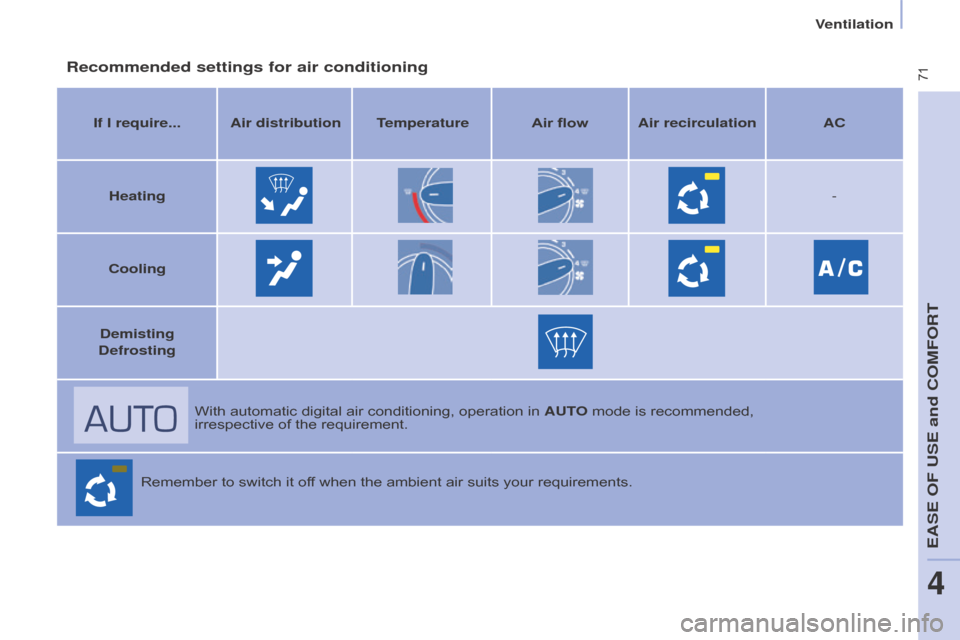
71
Berlingo-2-VP_en_Chap04_Ergonomie_ed01-2015Berlingo-2-VP_en_Chap04_Ergonomie_ed01-2015
Recommended settings for air conditioning
If I require... Air distribution TemperatureAir flowAir recirculation AC
Heating -
Cooling
Demisting
Defrosting
With
automatic digital air conditioning, operation in AUTO mode is recommended,
irrespective
of the requirement.
Remember
to switch it off when the ambient air suits your requirements.
EASE OF USE and COMFORT
4
Ventilation
Page 74 of 298
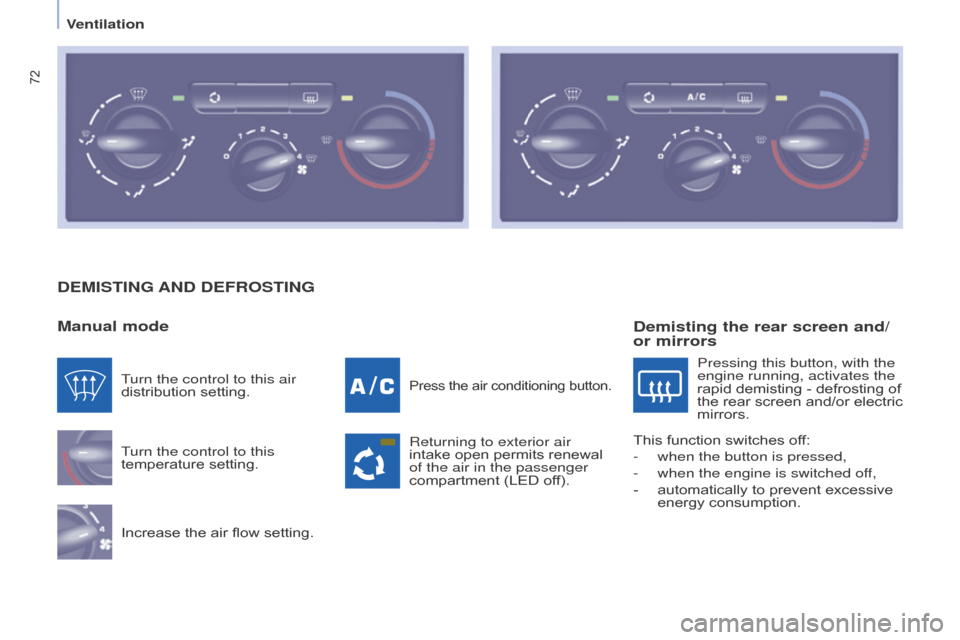
72
Berlingo-2-VP_en_Chap04_Ergonomie_ed01-2015Berlingo-2-VP_en_Chap04_Ergonomie_ed01-2015
DEMISTING AND DEFROSTING
Manual mode
Turn the control to this
temperature setting.
Increase
the air flow setting.
Press the air conditioning button.
Returning to exterior air
intake open permits renewal
of the air in the passenger
compartment
(LED off).
Turn the control to this air
distribution
setting.
Demisting the rear screen and/
or mirrors
Pressing this button, with the
engine running, activates the
rapid
demisting - defrosting of
the
rear screen and/or electric
mirrors.
This
function switches off:
-
when the button is pressed,
-
when the engine is switched of
f,
-
automatically
to prevent excessive
energy
consumption.
Ventilation
Page 75 of 298
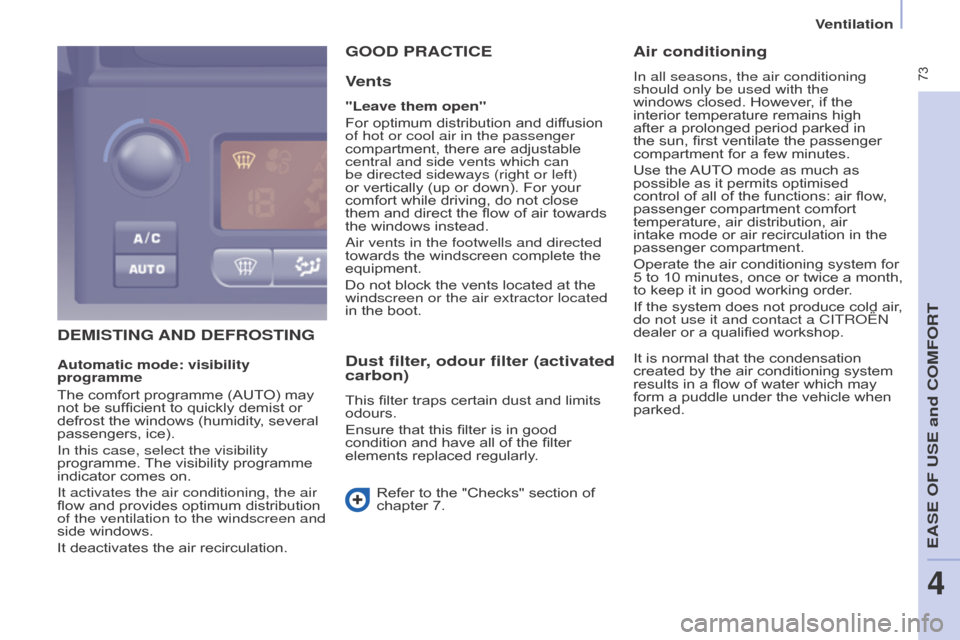
73
Berlingo-2-VP_en_Chap04_Ergonomie_ed01-2015Berlingo-2-VP_en_Chap04_Ergonomie_ed01-2015
DEMISTING AND DEFROSTING
G
OOD PRACTICE
V
ents
"Leave them open"
For
optimum distribution and diffusion
of hot or cool air in the passenger
compartment,
there are adjustable
central and side vents which can
be directed sideways (right or left)
or
vertically (up or down). For your
comfort
while driving, do not close
them
and direct the flow of air towards
the
windows instead.
a
ir vents in the footwells and directed
towards
the windscreen complete the
equipment.
Do
not block the vents located at the
windscreen or the air extractor located
in
the boot.
Dust filter, odour filter (activated
carbon)
This filter traps certain dust and limits odours.
Ensure that this filter is in good
condition
and have all of the filter
elements
replaced regularly.
Refer
to the "Checks" section of
chapter
7.
Air conditioning
In all seasons, the air conditioning
should only be used with the
windows closed. However, if the
interior
temperature remains high
after
a prolonged period parked in
the
sun, first ventilate the passenger
compartment
for a few minutes.
Use
the
AUT
O mode as much as
possible
as it permits optimised
control
of all of the functions: air flow,
passenger
compartment comfort
temperature,
air distribution, air
intake
mode or air recirculation in the
passenger
compartment.
Operate
the air conditioning system for
5
to
10
minutes,
once
or
twice
a
month,
to
keep it in good working order.
If
the system does not produce cold air,
do not use it and contact a CITR
o Ë n
dealer
or a qualified workshop.
Automatic mode: visibility
programme
The
comfort
programme
(AUTO)
may
not
be
sufficient
to
quickly
demist
or
defrost
the
windows
(humidity,
several
passengers,
ice).
In this case, select the visibility
programme.
The
visibility
programme
indicator
comes
on.
It activates the air conditioning, the air
flow
and
provides
optimum
distribution
of the ventilation to the windscreen and
side
windows.
It
deactivates
the
air
recirculation. It
is normal that the condensation
created
by the air conditioning system
results
in a flow of water which may
form
a puddle under the vehicle when
parked.
EASE OF USE and COMFORT
4
Ventilation
Page 76 of 298
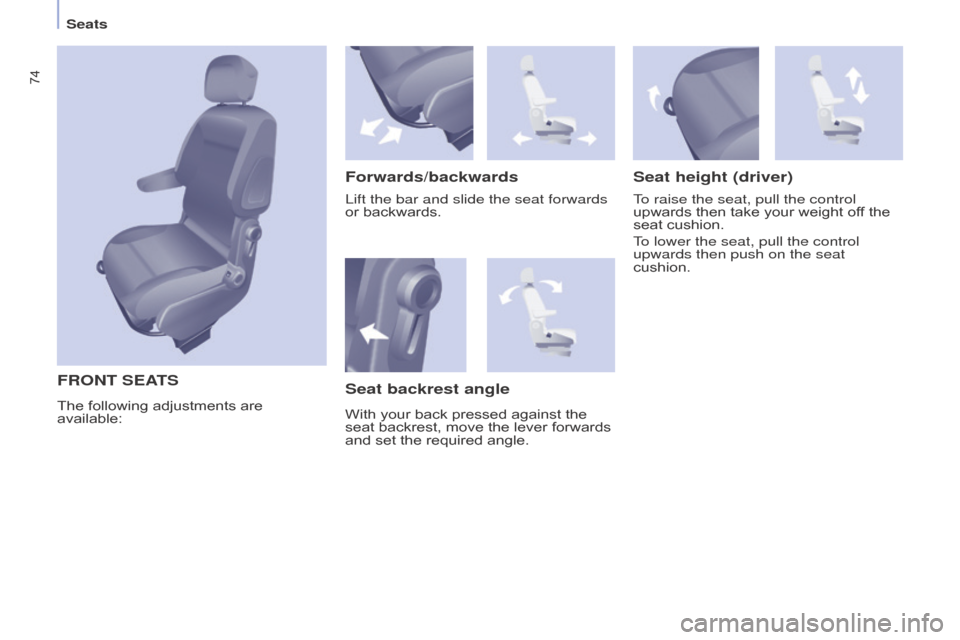
74
Berlingo-2-VP_en_Chap04_Ergonomie_ed01-2015Berlingo-2-VP_en_Chap04_Ergonomie_ed01-2015
FRONT SEATS
Forwards/backwardsSeat height (driver)
To raise the seat, pull the control
upwards
then take your weight off the
seat
cushion.
To lower the seat, pull the control
upwards then push on the seat
cushion.
Seat backrest angle
Lift the bar and slide the seat forwards
or backwards.
The
following
adjustments
are
available: With
your back pressed against the
seat
backrest, move the lever forwards
and
set the required angle.
Seats
Page 77 of 298
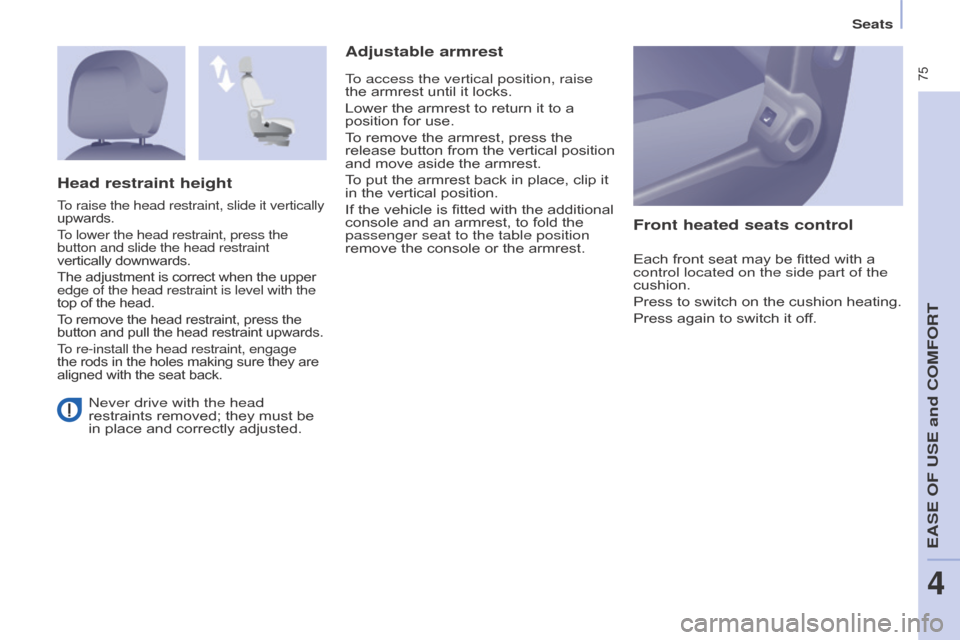
75
Berlingo-2-VP_en_Chap04_Ergonomie_ed01-2015Berlingo-2-VP_en_Chap04_Ergonomie_ed01-2015
never drive with the head
restraints removed; they must be
in
place and correctly adjusted.
Adjustable armrest
Front heated seats control
Each front seat may be fitted with a control located on the side part of the
cushion.
Press to switch on the cushion heating.
Press
again to switch it off.
Head restraint height
To raise the head restraint, slide it vertically
upwards.
To lower the head restraint, press the
button and slide the head restraint
vertically downwards.
The
adjustment is correct when the upper
edge of the head restraint is level with the
top
of the head.
To
remove the head restraint, press the
button
and pull the head restraint upwards.
To re-install the head restraint, engage
the
rods in the holes making sure they are
aligned
with the seat back.
To access the vertical position, raise
the armrest until it locks.
Lower
the armrest to return it to a
position
for use.
To
remove the armrest, press the
release
button
from
the
vertical
position
and
move aside the armrest.
To
put the armrest back in place, clip it
in
the vertical position.
If
the vehicle is fitted with the additional
console
and an armrest, to fold the
passenger seat to the table position
remove
the console or the armrest.
EaSE oF USE and CoMFoRT
4
Seats
Page 78 of 298

76
Berlingo-2-VP_en_Chap04_Ergonomie_ed01-2015Berlingo-2-VP_en_Chap04_Ergonomie_ed01-2015
REAR BENCH SEAT
Each 1/3 - 2/3 section can be fully folded, then removed individually.
Head restraint
The 1/3 - 2/3 split rear bench seat is fitted with "comma" shape head restraints.
High position: lift and raise the head restraint.
Low
position: press on the head
restraint
to lower it.
To
remove the head restraint, after
raising it press the tab and lift the head
restraint.
T
o install the head restraint, engage
the rods of the head restraint in the
holes
keeping it in line with the seat
back.
Seats
Page 79 of 298

77
Berlingo-2-VP_en_Chap04_Ergonomie_ed01-2015Berlingo-2-VP_en_Chap04_Ergonomie_ed01-2015
Fully folded position
Example of operations for the
1/3 section. They are identical for the
2/3
section. -
Raise the grey control bar
, located
at the rear of the seat cushion.
-
T
ilt the entire seat forward.
Putting back in place
Check that the seat is locked on the floor securely when it is
returned
to the sitting position.
-
Place the head restraints in the low
position.
-
If
necessary,
move
the
front
seats
forward.
-
Press the grey control located on
the
upper
part
of
the
seat
backrest.
-
Fold
the
seat
backrest
onto
the
seat
cushion. Tilt the entire seat rearwards until it
locks
into place.
Raise the seat backrest.
The
seat is locked correctly when the
control
(at the top of the seat back) is
no
longer visible.
EASE OF USE and COMFORT
4
Seats
Page 80 of 298

78
Berlingo-2-VP_en_Chap04_Ergonomie_ed01-2015Berlingo-2-VP_en_Chap04_Ergonomie_ed01-2015
Removing the bench seatRefitting the bench seat
Refer to the "Fully folded position",
described
previously. To return the bench seat
(1/3
section and/or 2/3 section) to
the "passenger carrying" position,
refer to the "Fully folded position"
described
previously.
-
T
ilt the entire seat rearwards by
approximately 45°.
-
Lift the bench seat
vertically to the
limit of the anchorages.
-
Straighten bench seat by tilting it
forwards
then lift it.
-
If
necessary, move the front seats
forward.
-
Place
the bench seat (1/3 section
and/or
2/3 section) in the fully
folded
position. -
Of
fer
up
the
bench
seat
(1/3
section
and/or
2/3 section) vertically.
-
Place
the hooks between the
two bars.
-
Fold
the bench seat rearwards.
Seats